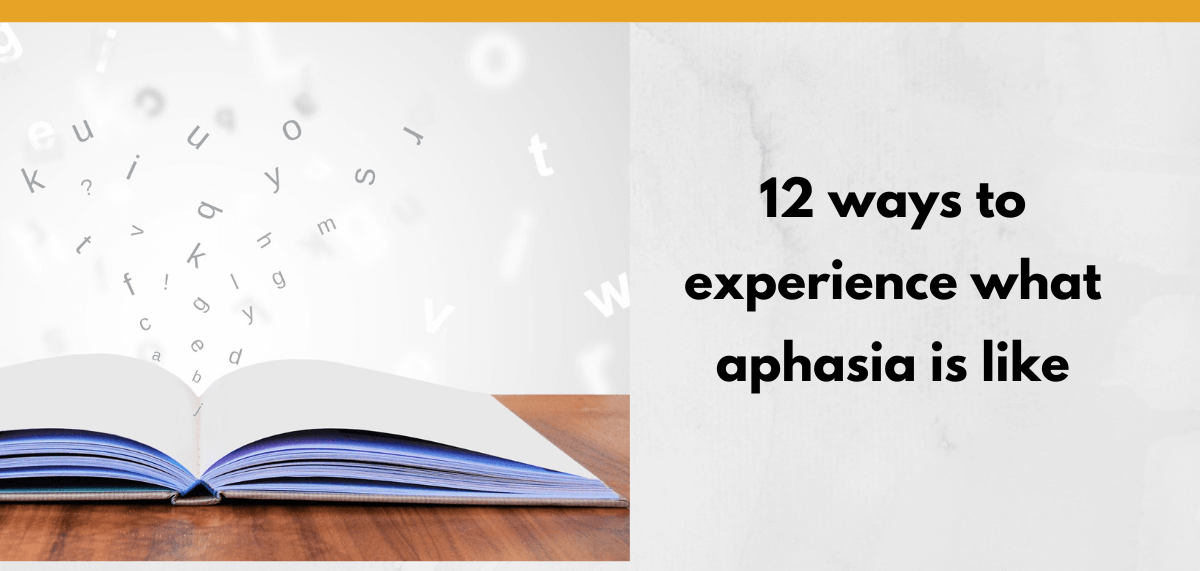To be clear, we can’t actually experience aphasia unless we have it. BUT we can try some interactive activities or watch some videos to gain a sense of what it might be like. Improving our understanding and empathy can go a long way to achieving better communication. You’ll also find helpful resources at the end.
Free DIRECT download: Experience aphasia (patient handout). (Email subscribers get free access to all the resources in the Free Subscription Library.)
Outline:
- What is aphasia?
- How are people with aphasia treated by others?
- Why experience aphasia for yourself?
- A day in the life, with and without communication aids.
- Experience aphasia with these interactive simulations.
- A real-life example of fluent aphasia.
- And here’s an example of non-fluent aphasia.
- See the social impacts of aphasia.
- A graceful reaction to rudeness.
- Teenage stroke survivor records yearly updates.
- Artist paints how she sees her world.
- Try one of these other immersive experiences.
- 4 resources for next steps.
- Related Eat, Speak, & Think posts.
What is aphasia?
Aphasia is an acquired communication impairment.
‘Acquired’ means you’re not born with aphasia. It’s something that happens to people after a stroke, brain injury, or a neurological disorder called primary progressive aphasia.
National Aphasia Association. (2018, May 28.)What is Aphasia? YouTube.
Aphasia can affect any area of communication: talking, understanding speech, reading, or writing. Impairments can range from mild to profound.
People with aphasia may or may not also have related conditions, such as:
- Difficulty pronouncing words (dysarthria)
- Trouble sequencing and coordinating speech sounds (apraxia of speech).
- Cognitive problems, such as impaired attention and impulse control.
Aphasia may disappear soon after onset, but for many people it is a chronic problem that affects every area of life.
How are people with aphasia treated by others?
People with aphasia have to deal with:
- Stereotyping (others assuming they are mentally impaired or drunk).
- Rudeness (people walking away or hanging up on them).
- Patronizing (treating the person like a child).
- Isolation (avoiding talking to them).
Why experience aphasia for yourself?
Like I said above, unless we have aphasia, we won’t really know what it’s like. BUT we can try some interactive activities or watch some videos to gain a little taste of what it might be like.
Regaining lost communication skills can take years. And even though a person may improve from year to year, they may never communicate like they did before a stroke.
Depending on how impaired a person is, this means that every single communication attempt may be very challenging, difficult, incomplete or slower than normal.
Every time. Every single day.
So it’s easy to see how people who communicate fluently can become frustrated with people who have challenges.
And, naturally, it’s very easy to see how people with aphasia may become frustrated, discouraged, and depressed.
Trying to gain a tiny sense of what it’s like to have aphasia can be a powerful way to change how we think about it. Continue reading to find resources that can help provide this experience.
A day in the life, with and without communication aids
This is the most powerful video I have seen in terms of showing what it’s like to live with aphasia.
Watch this woman go through a typical day without being able to communicate effectively.
Then watch her go through a similar day when she has access to some simple communication aids and friends and family who have learned how to offer helpful support for her situation.
By the way, I’ve been a speech-language pathologist for a good number of years, and I learned some good ideas from this video.
Experience aphasia with these interactive simulations
Voices of Hope for Aphasia has four sets of interactive simulations of what it’s like to have aphasia.
Try your hand at listening, reading, writing, or speaking with aphasia.
A real-life example of fluent aphasia
Fluent aphasia is also called Wernicke’s aphasia. In fluent aphasia, people speak in connected sentences, but they don’t necessarily make sense. People with fluent aphasia often also have impaired understanding.
And here’s an example of non-fluent aphasia
Non-fluent aphasia is also called Broca’s aphasia. This gentleman, Mike Caputo, is one of the founders of Voices of Hope for Aphasia.
See the social impacts of aphasia
Nicholas suffered multiple strokes after a terrible road accident. This is a very moving and beautiful video showing the social and emotional side of aphasia.
A graceful reaction to rudeness
When asked what it’s like to have aphasia, this woman’s first point is that strangers think she is intellectually impaired.
Teenage stroke survivor records yearly updates
Sarah Scott experienced a stroke at age 18, likely due to an undiagnosed hole in her heart. She has been uploading a video to YouTube every year.
In her earliest video, you can see her slow, halting speech. She has frequent failures to communicate her ideas. She has her notebook handy, which helps her to find her words sometimes. And sometimes the woman behind the camera (I think her mother) fills in for her.
In this video thirteen years later, she is much more fluent. You can see she still has a little trouble, and numbers are still challenging for her. She is now working and volunteers for several charities. And she’s engaged!
Artist paints how she sees her world
Deonna Keiser, an artist, uses drawing to help communicate because she has non-fluent aphasia. She even literally painted how she sees the world after her stroke and took a picture of it to show her doctor.
Try one of these other immersive experiences
Most of us probably studied another language in high school. If you have even a basic understanding of another language, you may be able to gain a sense of what it would be like to have aphasia.
Don’t do this
My original thought was to suggest picking a different language from an automated phone menu than the one you’re most comfortable in. But what if someone did this for their bank account and made some unfortunate choice? (Don’t do this!)
((I did this once while studying Spanish in college, just to check my bank balance. But I quickly lost my nerve with the automated menu – too many words going by too rapidly, and I hung up.))
So I’ll suggest some “safer” alternatives than trying to bank in an unfamiliar language.
3 immersive activities that may convey a mild to severe aphasia
These activities may help you consider what it’s like to have a mild to severe aphasia. Pick a language that you have some skill with, but aren’t fluent in.
My goal is to give you a taste of what it’s like to be in a situation where you have a decent understanding of what’s going on, but you fail at participating in a fully-fluent way.
- Find an instructional YouTube video in your alternate language. It could be cooking, a craft, yoga, a household tip, or even “Hands, Shoulders, Knees, and Toes”. Try actually doing the thing. See if there’s a difference if you don’t look at the screen.
- Change the language on your favorite media. Maybe mute it and put on subtitles in the language you studied. Can you follow it easily? Can you multi-task while watching it? Can you close your eyes and understand as well?
- Stay alert as you go through the day. If you hear someone speaking a language you kinda know, greet them in that language. Try to have a short conversation, if appropriate. Maybe ask them what time it is or if they know how to get to a nearby place. Were you successful? Did you feel anxious? Was the other person patient?
1 activity to help you simulate a profound aphasia
Finally, if you want to simulate a profound impairment, choose to experience a language you don’t know at all. For instance, here are some things to think about as you watch this cooking lesson in Welsh.
Imagine that this is a cooking segment in English that you’re watching after an imaginary stroke. You know what carrots and potatoes are. But you know longer recognize the words for them, either spoken or written. You can no longer talk about cooking or order your favorite foods at a restaurant. What would that be like?
Or maybe even try to follow the video to make the soup. If you’re an experienced cook, you can probably manage. But I bet it would take a fair bit longer than watching a similar video in English. Just imagine if everything you did all day long took longer than normal. What activities would you have to cut out of your day just to fit in the essentials?
Here’s how I found this video, in case you want to choose a different language or find a different topic. I went to Google Translate and typed in “recipe vegetable soup” on the left-hand side. Then on the right-hand side, I selected a language that not a lot of people know (Welsh). I copied the translation and plugged it into YouTube.
4 resources for next steps
I have some suggestions for you if you want to learn what you can do to make communication easier with people who have aphasia.
- 10 tips from the Mayo Clinic.
- Aphasia Etiquette in rhyme from the Stroke Association (YouTube video).
- Free course to improve conversation skills from University College London (one for general public, one for professionals).
- Free introduction to Supported Conversation for Adults with Aphasia, from the Aphasia Institute.
Related Eat, Speak, & Think posts
- Free low-tech AAC for adults.
- How to shape words from numbers to improve speech.
- Improve aphasia outcomes by creating intensive home exercise programs.
- How intensive home exercise helped my patient talk again.
Free DIRECT download: Experience aphasia (patient handout). (Email subscribers get free access to all the resources in the Free Subscription Library.)
Featured image by Mediamodifier on pixabay.
Lisa earned her M.A. in Speech-Language Pathology from the University of Maryland, College Park and her M.A. in Linguistics from the University of California, San Diego.
She participated in research studies with the National Institute on Deafness and other Communication Disorders (NIDCD) and the University of Maryland in the areas of aphasia, Parkinson’s Disease, epilepsy, and fluency disorders.
Lisa has been working as a medical speech-language pathologist since 2008. She has a strong passion for evidence-based assessment and therapy, having earned five ASHA Awards for Professional Participation in Continuing Education.
She launched EatSpeakThink.com in June 2018 to help other clinicians be more successful working in home health, as well as to provide strategies and resources to people living with problems eating, speaking, or thinking.



Be First to Comment